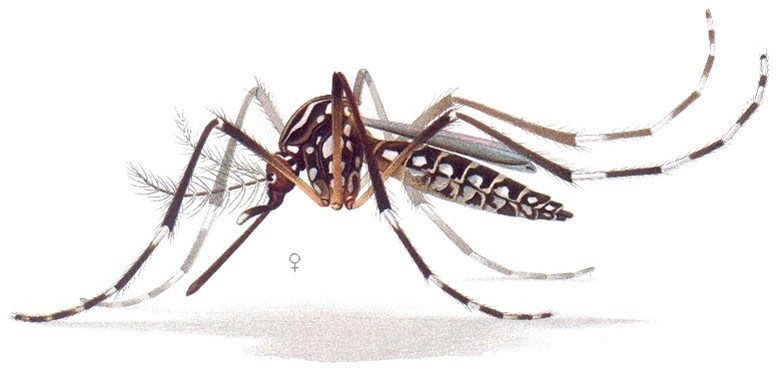
Credit: Detail from the original by Emil August Goeldi, public domain, via Wikimedia Commons
Background
Synopsis: When a mosquito bites, it transmits pathogens that can be deadly to humans including malaria, dengue fever, West Nile virus, Zika virus, yellow fever and others. Each year, hundreds of thousands of humans die, and millions are sickened by these small but deadly insects. Insecticide sprays, mosquito nets, and access to medication have their limitations. A new approach involving a natural bacterium, Wolbachia, shows great promise in combating mosquito-borne diseases.
- Mosquitoes are Earth’s deadliest animal killing an estimated 1 million people and causing sickness for nearly 250 million annually. (refer to EarthDate ED-221: Mosquito Inspired Injection),
- Found worldwide except in Antarctica, mosquitoes include over 3000 species across 112 genera, though most species are nuisance mosquitoes that do not carry disease, yet still bite humans.
- Harmful mosquito genera are known as vectors in that they transmit parasites or germs to their hosts. These include:
- Aedes: causing dengue, yellow fever, Zika, Rift Valley fever, Chikungunya, and lymphatic filariasis
- Anopheles: causing malaria, lymphatic filariasis, and o'nyong'nyong virus
- Culex: causing West Nile fever, lymphatic filariasis, and Japanese encephalitis
- Most vector mosquitoes are found in tropical and subtropical regions and have the greatest impact in developing nations.
- Mosquitoes are not the source of these diseases, but rather, they are infected with them when they bite an infected person. Mosquitoes then spread the virus through subsequent bites.
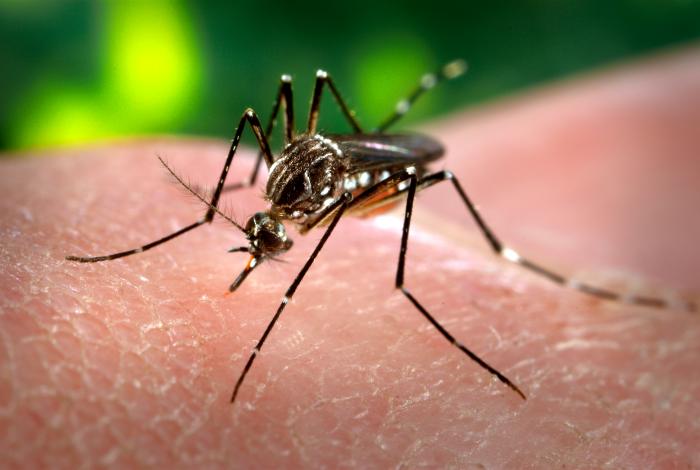
This Aedes aegypti mosquito is often called the yellow fever mosquito but it can also transmit dengue fever, Zika, and Chikungunya. Key features include the white stripes on its’ legs and a marking that looks like a lyre on its thorax, behind the head.
Credit: James Gathany, public domain, via Wikimedia Commons
- Malaria is the deadliest mosquito-borne illness, with symptoms such as fever, chills and headache. In severe cases, fatigue, difficulty breathing, convulsions, and abnormal bleeding may occur.
- Many medicines exist to treat malaria although there has been some drug resistance reported in the last 10 years. Vaccines and other preventative medicines provide the best defense for treatment in addition to improving access to healthcare.
- Dengue fever, on the other hand, does not have any specific medications for prevention or treatment. Controlling the symptoms of fever, nausea, headache, and rashes among others is the usual approach. Severe cases cause extreme weakness, excessive vomiting, and rapid breathing.
- The World Health Organization (WHO) reports a growing number of cases of dengue fever with the number of cases swelling from about 500,000 reported in 2000 to 6.5 million reported in 2023, the most ever.
- Factors contributing to this include growing populations in tropical and subtropical regions, particularly in urban and semi-urban areas, increased precipitation and temperature, more international travel, and stressed health care systems post-Covid.
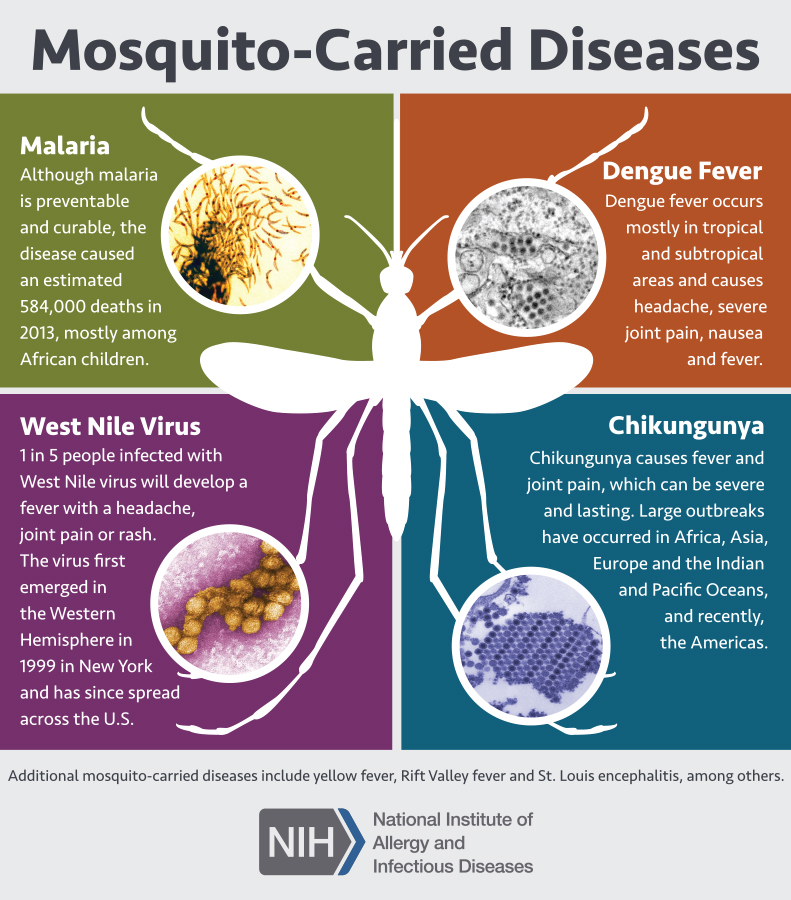
A poster informing the public about the many mosquito-borne diseases.
Credit: NIAID, CC BY 2.0, via Wikimedia Commons
- Most prevention campaigns focus on the actions of individuals and limiting the breeding of mosquitoes.
- People in high impact areas are encouraged to wear clothing that covers the skin, sleep in mosquito-nets, install window screens and use approved insecticides.
- Mosquitoes need water to lay eggs during breeding, so preventing standing water is key. Covering municipal water supplies, removing any containers in and around the home that hold water, and applying approved insecticides in outdoor water storage sites prevent the creation of a successful breeding habitat.
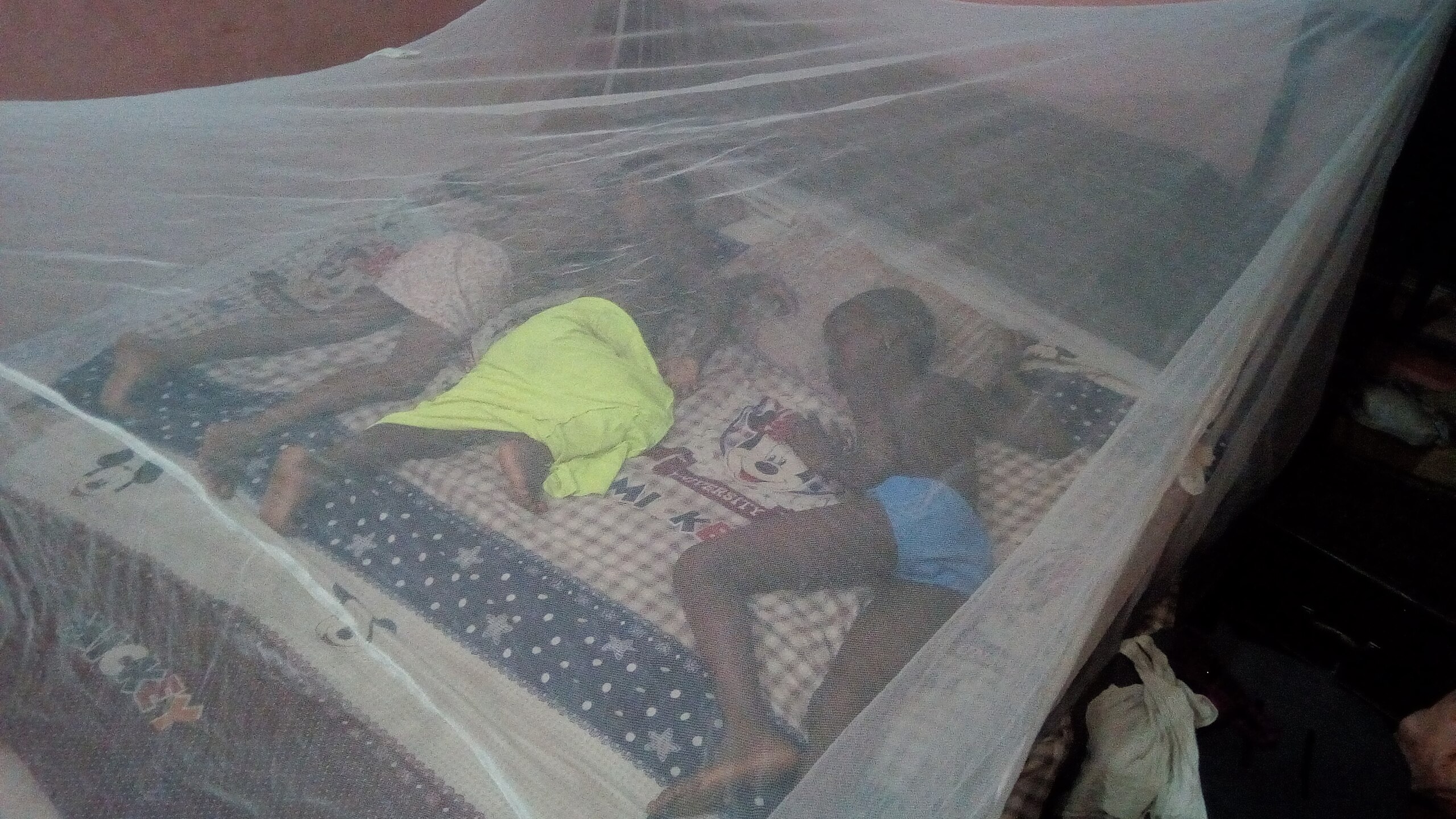
Sleeping under an insecticide treated net to avert malaria in Africa.
Credit: HarunaSylvester, CC BY-SA 4.0, via Wikimedia Commons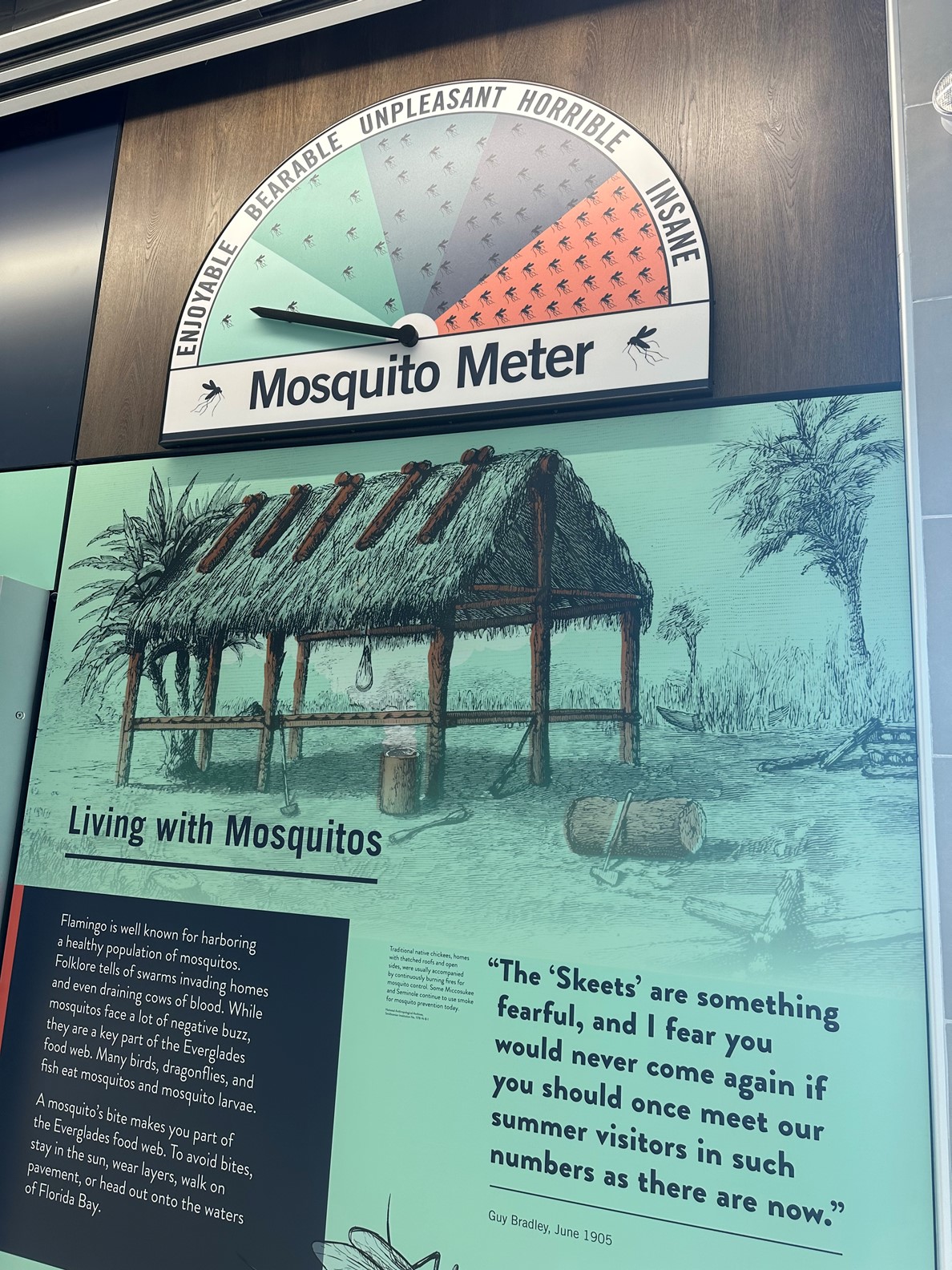
The Mosquito Meter at the Flamingo Visitor Center at Everglades National Park, Florida.
Credit: Lynn Kistler
- While these measures are helpful, the recent surge of dengue fever has led governments and researchers to look for other techniques to reduce the spread of this disease. One solution uses the naturally occurring bacterium, Wolbachia. Wolbachia is found in up to 50% of all insect populations and arthropods including spiders, butterflies, moths, and some mosquito species.

Three Wolbachia bacteria living inside the cell of a moth.
Credit: Adapted from SL O’Neill: This image was originally taken by SL O’Neill and is available under a creative commons license via the journal PLoS Biology.- A sterility approach is one method. Wolbachia carrying males are released into a population to control reproduction. When these males mate with a non-Wolbachia female, the eggs are not viable and will not hatch. This will lead to a decreased population.
- With this approach, the release of additional Wolbachia carrying males will need to continue as mosquitoes from surrounding areas may enter the population and counteract the effect. This method requires significant monitoring and involves additional maintenance costs to produce and then release more Wolbachia mosquitoes.
- Another method relies on a symbiotic relationship that Wolbachia bacteria has with host species, influencing functions such as metabolism, immunity, overall fitness and reproduction.
- Viruses like Dengue and Zika survive and grow by consuming essential molecules like cholesterol. So does Wolbachia.
- When Wolbachia is present in a mosquito, it consumes these essential molecules, preventing the viruses from growing and then being transmitted to humans.
- The Aedes aegypti mosquito species, responsible for dengue fever, Zika, yellow fever, and Chikungunya, does not naturally have the Wolbachia bacterium.
- Scientists from the World Mosquito Program have been able to boost the immunity of the Aedes aegypti mosquito by breeding it with Wolbachia mosquitoes, releasing both male and females into a specific native population.
- With successive generations occurring within weeks, the bacteria pass from one generation to the next and the Wolbachia mosquitoes can become predominant in the local area.
- With the bacteria present, the dengue, yellow fever, and other viruses cannot survive, and the mosquitoes no longer transmit them.
- In neighborhoods where Wolbachia mosquitoes have become well established, rates of dengue fever have dropped by about 95%. In Colombia, cases of dengue have dropped to a 20-year low after release of Wolbachia mosquitoes.
- This population replacement method typically involves a one-time release of Wolbachia containing mosquitoes and is long-term.
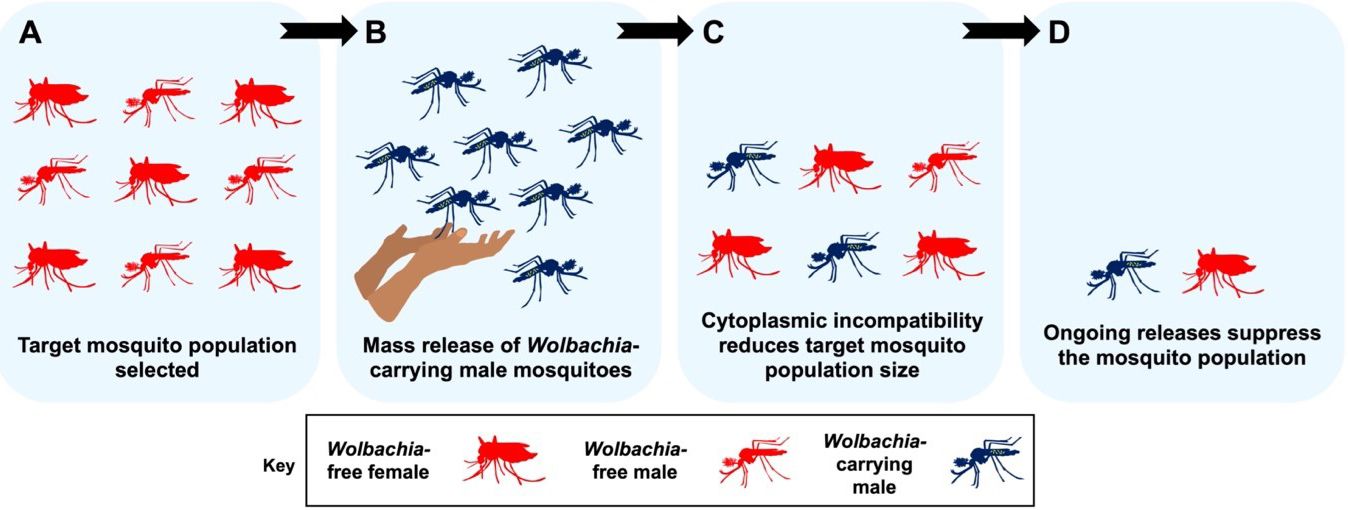
The process of releasing male and female Wolbachia-carrying mosquitoes to eventually replace a targeted population that carries disease.
Credit: E. Caragata, University of Florida/IFUS; CC BY-NC-ND 4.0
- A sterility approach is one method. Wolbachia carrying males are released into a population to control reproduction. When these males mate with a non-Wolbachia female, the eggs are not viable and will not hatch. This will lead to a decreased population.
- Extensive testing in both laboratory and field studies have consistently shown that Wolbachia is safe to humans, other animals, and the environment.
- Mosquitoes are a vital component of many food webs and there have been no effects on their predators in the food chain.
- Both methods are proving to be effective, and many more countries are getting on board with this new means to reduce the effects of the deadly mosquito.
- Several types of agricultural pests are also affected by Wolbachia and there is a push to further study this avenue of pest control for agriculture to reduce our reliance on pesticides and prevent further pesticide resistance.
Episode Script
What’s the world’s most dangerous animal?
Sharks? Nope, they bite only 70 people a year, with just six fatalities. Poisonous snakes? They kill about 50,000.
But far and away the most dangerous is the mosquito. It kills a million people a year, and sickens 250 million more! But we may be able to stop it, with an even tinier creature.
There are 3,000 species of mosquito. Different ones can carry malaria, West Nile virus, Zika, yellow fever, dengue, Japanese encephalitis, and more.
They don’t cause these diseases, but instead bite an infected person, then pass it to others.
Some of these diseases, like malaria, have medicines to prevent and treat them. Others like dengue, don’t.
But scientists may have found a novel solution – infecting the mosquitoes themselves, with bacteria called Wolbachia.
Wolbachia exist symbiotically in about 50% of insect species. When introduced to mosquito populations, they consume essential molecules within the insect, like cholesterol -- the same thing that Zika and dengue rely on.
This means those diseases can’t survive within the mosquito and can’t be transferred to more humans.
Wolbachia don’t kill the mosquitoes, and are found to be harmless to humans and other creatures that depend on mosquitoes for food, like birds and bats.
A microbiological treatment for a global disease problem.

